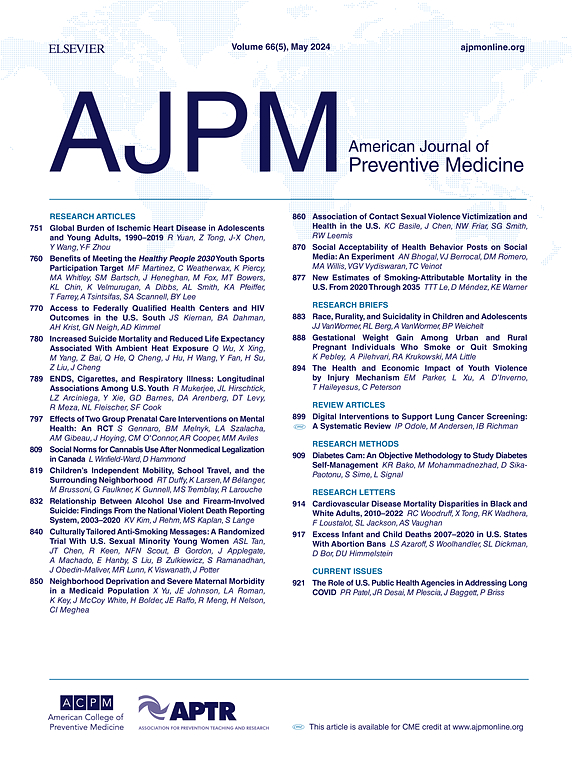Nonfatal Injuries Among Skilled Nursing and Residential Care Facility Workers Treated in U.S. Emergency Departments, 2015–2022
IF 4.3
2区 医学
Q1 MEDICINE, GENERAL & INTERNAL
引用次数: 0
Abstract
Introduction
Skilled nursing and residential care facilities report among the highest nonfatal occupational injury rates compared to the overall working population. This cross-sectional study reports nonfatal emergency department -treated injury national estimates among U.S. skilled nursing and residential care facility workers.
Methods
Nonfatal ED-treated occupational injury data were analyzed (2015–2022) from the National Electronic Injury Surveillance System, Occupational Supplement, a national probability sample of approximately 67 U.S. emergency departments. Occupational injuries in skilled nursing and residential care facilities were selected using relevant U.S. Census Bureau industry codes. National estimates and rates per 10,000 worker full-time equivalents were calculated using the U.S. Current Population Survey. Piecewise linear regression models examined temporal trends in biannual injury rates.
Results
An estimated 569,800 (95% CI = 420,400; 719,200) injuries occurred from 2015 to 2022, a rate of 302 (223, 382) per 10,000 full-time equivalents. Most injuries occurred among females (81%). The most prevalent injury events were overexertion and bodily reaction (38%; 116 [85, 147] per 10,000 full-time equivalents), violence (24%; 73 [46, 100] per 10,000 full-time equivalents), and falls, slips, and trips (16%; 49 [35, 63] per 10,000 full-time equivalents). Skilled nursing and residential care facility injury rates were higher than the rest of the healthcare industry and all industries. Skilled nursing and residential care facility injury rates declined from 2015–2021 (average biannual change –9.6% [–13.3%, –5.9%], p<0.001]). Following a 2021 trend change, there was a non-significant increase in injury rates.
Conclusions
Among the working population, skilled nursing and residential care facility workers experience a high rate of nonfatal emergency department–treated occupational injuries. Future research should confirm trends and study effectiveness and uptake of evidence-based injury prevention interventions across settings.
2015-2022年在美国急诊科接受治疗的熟练护理人员和寄宿护理机构工作人员的非致命伤害
简介:与总体工作人口相比,熟练护理和住宿护理设施(snrcf)是非致命职业伤害率最高的场所之一。本横断面研究报告了美国SNRCF工人非致命性急诊科(ED)治疗损伤的全国估计。方法:分析来自国家电子伤害监测系统、职业补充(National Electronic injury Surveillance System, occupational Supplement)的2015-2022年非致命性ed处理的职业伤害数据,这是一个大约67名美国ed的全国概率样本。根据美国人口普查局的相关行业代码,选择了snrcf中的职业伤害。使用美国当前人口调查计算了全国估计和每10,000名全职工人(fte)的比率。分段线性回归模型检验了双年伤害率的时间趋势。结果:从2015年到2022年,估计发生了569,800(95%置信区间420,400-719,200)起伤害,发生率为每10,000名fte中有302(223-382)起。大多数伤害发生在女性中(81%)。最常见的伤害事件是过度劳累和身体反应[38%;116(85-147 / 10,000),暴力[24%;73 (46-100 / 10,000 fte),以及跌落、滑倒和起下钻[16%;49(35-63) / 10,000]。SNRCF伤害率高于其他医疗保健行业和所有行业。从2015年到2021年,SNRCF伤害率下降了[平均两年变化-9.6% (-13.3%,-5.9%),p结论:在工作人群中,SNRCF工人经历非致命性ed治疗职业伤害的比例很高。未来的研究应确认趋势和研究的有效性,并采用基于证据的伤害预防干预措施。
本文章由计算机程序翻译,如有差异,请以英文原文为准。
求助全文
约1分钟内获得全文
求助全文
来源期刊

American Journal of Preventive Medicine
医学-公共卫生、环境卫生与职业卫生
CiteScore
8.60
自引率
1.80%
发文量
395
审稿时长
32 days
期刊介绍:
The American Journal of Preventive Medicine is the official journal of the American College of Preventive Medicine and the Association for Prevention Teaching and Research. It publishes articles in the areas of prevention research, teaching, practice and policy. Original research is published on interventions aimed at the prevention of chronic and acute disease and the promotion of individual and community health.
Of particular emphasis are papers that address the primary and secondary prevention of important clinical, behavioral and public health issues such as injury and violence, infectious disease, women''s health, smoking, sedentary behaviors and physical activity, nutrition, diabetes, obesity, and substance use disorders. Papers also address educational initiatives aimed at improving the ability of health professionals to provide effective clinical prevention and public health services. Papers on health services research pertinent to prevention and public health are also published. The journal also publishes official policy statements from the two co-sponsoring organizations, review articles, media reviews, and editorials. Finally, the journal periodically publishes supplements and special theme issues devoted to areas of current interest to the prevention community.
 求助内容:
求助内容: 应助结果提醒方式:
应助结果提醒方式:


